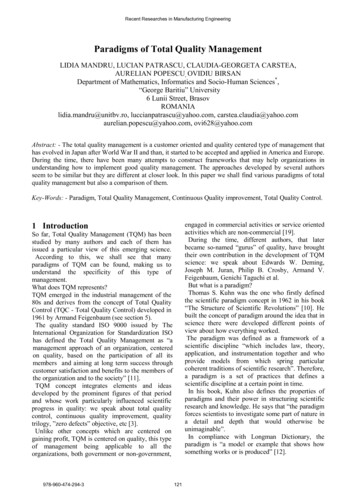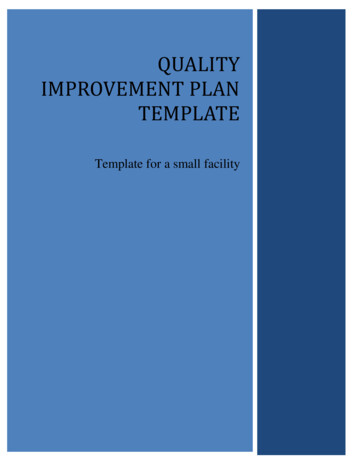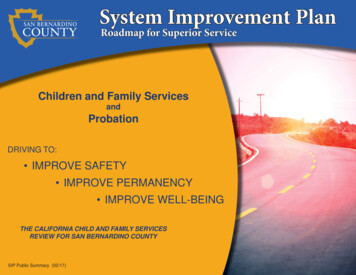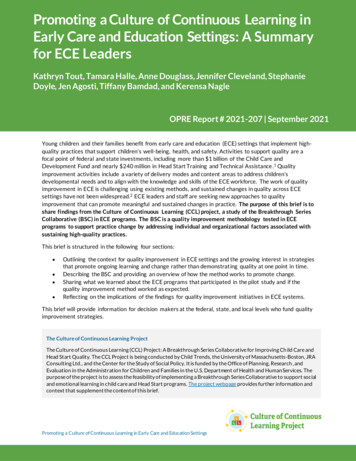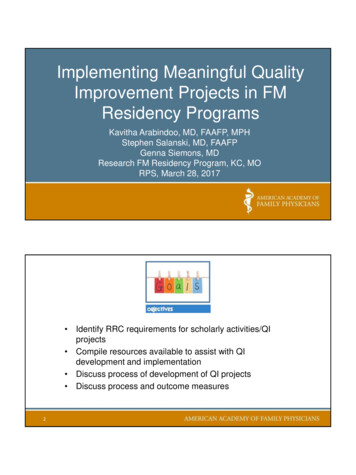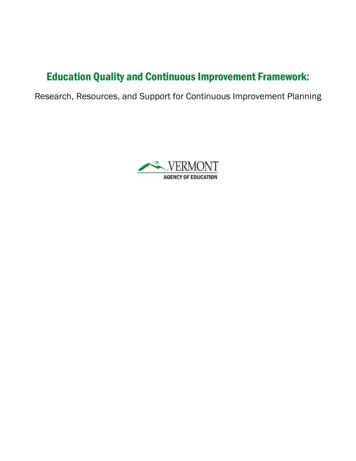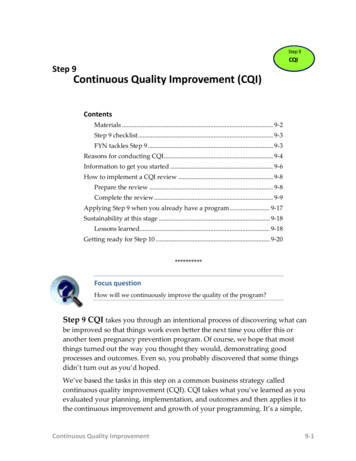
Transcription
2019/20 QOF:Quality ImprovementCase StudiesApril 20191
ContentsPurpose of this document . 3Case Study 1: Prescribing Safety . 4Project 1. Safer NSAIDS project . 4Project 2. The valproate pregnancy prevention project . 6Project 3. The lithium safer monitoring project . 7Case Study 2: End of Life Care. 9Case Study 3: End of Life Care. 122
Purpose of this documentThe 2019/20 changes to the Quality and Outcomes Framework included the introduction of a qualityimprovement (QI) domain. This booklet contains three case studies developed by the Royal Collegeof General Practitioners, National Institute for Health and Care Excellence and the HealthFoundation which provide examples of how practices could approach their quality improvementactivity.3
Case Study 1: Prescribing SafetyPractice details: 5200 patients, urban practice.Members of the practice team have undertaken small QI projects in the past, mainly based onsignificant event analysis and registrar-led clinical audits. A project team was formed consisting of aGP, a GP registrar, the practice pharmacist (project lead), and a medical secretary.The team decided to focus on NSAIDprescribing as its first priority. They usedthe RCGP QI wheel for general practiceavailable in RCGP How to get started in QIguide for advice.Culture and context – the project team asked the next whole practice team meeting attendees tojointly do a quick SWOT analysis (strengths, weakness, opportunities and threats) on prescribingsafety in the practice. The clinical staff members present identified they had weak systems forchecking safe prescribing, alerts were often ignored, and many patents were overdue a medicationreview. Some of the team felt there is a fear of being blamed if something goes wrong and theythink it’s only the GPs’ job to ensure prescribing is safe. The practice team expressed a wish to movethe culture to one of no-blame and learning from patient safety incidents. It was agreed to dedicatethe next Protected Learning Time (PLT) to prescribing safety. In preparation for this, every staffmember would be asked to complete a short anonymous survey giving them the opportunity todescribe one potential patient safety incident they had been aware of in the last 12 months. Thisstarted to allow the practice to review its systems and processes for protecting services. The clinicalpharmacist agreed to review the PISA Patient Safety Incident Reporting Form Template to adopt intothe practice and to refresh the practice’s significant event audit (SEA) template as the way ofrecording the QI activity. This would then be tested with the team at the next PLT event.Project 1. Safer NSAIDS projectDiagnose – the GP registrar supported by the GP created clinical record searches to identify patientsat risk of harm due to NSAIDS prescribing focussing on those with a past history of peptic ulcerdisease.Plan and test – the project team then used this data to inform their next actions and set a clear plan:4
a) Aim – Within one month of the project, no patients on the registered list with a past historyof peptic ulcer disease would be prescribed an NSAID without co-prescribing a proton-pumpinhibitor.b) Measure – A list of patients identified as at risk will be reviewed every week by the practicepharmacist to ensure that by the end of the four weeks, all patients have been reviewed. Athree-monthly prescribing search would be carried out to demonstrate maintenance of thistarget.c) The change – the practice pharmacist attended the 1st peer review with fellow project leadsfrom the local Primary Care Network and discussed the findings of the diagnosis step andshared ideas with local practices about suggested actions to test.I.A receptionist was tasked with contacting the identified patients and booking anurgent medication review with the practice pharmacist, an advanced nursepractitioner or a GP.II.The practice’s clinical coder undertook a search of all patients with a past code forpeptic ulcer disease to ensure the code was amended to be clearly visible to allprescribers in future and was easily searchable.III.The practice manager ensured that all prescribing electronic alerts were switched onin the clinical system and all prescribers reminded of the importance of checkingthese alerts.Implement and embed. All staff underwent a short training exercise with the project lead at thenext PLT event so everyone was aware of what the practice was trying to achieve. The practicerecalled all patients identified as at risk within four weeks and took appropriate clinical action foreach patient to reduce the risk. Some patients were able to stop the NSAID altogether and some hada proton pump inhibitor added.Sustain and spread. By reviewing the search at the end of the first month, the project team wereencouraged that the QI activity had initially achieved the aim. They shared this with the wholepractice team with a “What we’ve all achieved” poster on the staff noticeboard.The practice manager set up a three-monthly search to ensure no new at risk patients emerged, andthe clinical pharmacist reviewed this every three months.It was agreed that any new patients identified after this intervention should be reported through thenew PISA Patient Incident Form and be subject to a practice-based Significant Event Analysis to helpidentify ongoing issues that may need to be addressed through new improvement cycles.The GP registrar presented the summary of the QI activity at the 2nd Primary Care Network peerreview meeting and was able to use the work as evidence in her training portfolio.What the practice did next?It was agreed to extend the search criteria for all patients over 65 years old prescribed any NSAIDmedication without co-prescription of a PPI in the last 12 months and all patients taking repeatprescriptions for NSAIDS. To undertake a virtual or telephone clinical review (led by the clinicalpharmacist) of all patients over the next 6 months. The improvement cycle begins again.5
Project 2. The valproate pregnancy prevention projectDiagnose – the practice pharmacist ran a search for any prescriptions for valproate issued within thelast 3 months in girls and women of childbearing potential.Plan and test – the team, made up of the pharmacist, lead practice nurse, and a medical secretary,were reassured that no patients were identified. However they wanted to ensure a practice-basedsystem was developed to ensure compliance with the MHRA pregnancy prevention guidelines.a) Aim – To ensure that valproate is not prescribed to girls of any age or woman of childbearingpotential without a pregnancy prevention plan in place.b) Measure – Repeated monthly prescribing searches of registered patients show no at-riskpatients.c) The change - the practice pharmacist attended the 1st peer review and discussed thefindings of the diagnosis step and shared ideas about suggested actions to test.i.All prescribing staff to be reminded of the Valproate Pregnancy Prevention packssent to all practices by MHRA, which include professional and patient information, atthe next clinical team meeting. The practice administrator ensured packs areavailable in all consulting rooms, including in locum information and registrarinduction packs.ii.Pharmacist set up monthly search and is tasked with checking the results andreporting back to the lead practice nurse (with a regular slot marked on her dailycalendar as a reminder).Implement and embed. The two changes were implemented. The pharmacist ran a search (createdby NHS Digital) and the lead practice nurse used her dedicated QI slot to check the results eachmonth. Any identified patients would have been called in by the medical secretary to discuss theirmedication but so far, no patients were identified.Sustain and spread. The medical secretary realised that hard copies of the MHRA guidance could runout, so she kept an electronic file of the Valproate Pregnancy Prevention packs available. It wasagreed that the practice nurse would continue to run the monthly search. The project lead alsoattended the 2nd peer review meeting with colleagues from the local primary care network andshared the team’s work.What the practice did next?The practice manager and lead GP were confident that the practice now had a safe system in placeto identify new patients who may be affected by valproate prescribing and risk of pregnancy. Theyagreed to add this to the lead nurse’s mid-year and annual appraisal as an objective to ensure thesystem remained in place.6
Project 3. The lithium safer monitoring projectDiagnose – a project team was set up and led by a senior healthcare support worker, supported by aGP and the reception team leader. An initial search (set up by the practice pharmacist who taughtthe healthcare support worker how to run it) was undertaken which identified five patients currentlybeing issued lithium prescriptions.Plan and test – the team were joined at the planning meeting by a patient volunteer who was beingprescribed lithium. The patient helped the team to map how prescriptions were ordered and issuedand how monitoring was undertaken. This group set the project’s aim, measures and changes whichwere also discussed with colleagues at the 1st primary care network peer review meeting.a) Aim – All patients prescribed lithium have appropriate lithium blood test monitoring oninitiation and at recommended intervals as part of the holistic care they are offered for theirmental health condition.b) Measure – A three-monthly search of all patients prescribed lithium would be carried out,identifying those with and without recorded blood concentration results within the last 3months.c) The change:i.Two electronic searches to be set up. One monthly search would be carried out to lookat all patients with lithium on their repeat prescription with and without issues in thelast 3 months (to identify early any underuse which could suggest low compliance withtreatment leading to clinical deterioration). One three-monthly search would monitor allthose prescribed lithium having regular blood monitoring performed.ii.All patients showing possible medication underuse, failure to attend for monitoring, orblood monitoring levels outside acceptable range would have a robust follow up plan tobe used by the practice staff and co-designed by the practice, and a focus group ofpatients who are (or have been) prescribed lithium.Implement and embed. The searches were set up and the results monitored by a healthcare supportworker who had a supervising GP to whom he could take concerns about specific patients.The healthcare support worker and the reception team leader invited a group of patients who wereor who had been prescribed lithium to join a one-off focus group to discuss their perspectives andsuggestions for the proposed management plans. It was agreed that a new follow up protocol andmanagement plan would be tested for six months, and then measured to see if concordance withmonitoring improved. A further measure was added, at a patient’s suggestion, of whether anypatients had become unwell from not taking lithium appropriately during those six months. Asignificant event analysis or root cause analysis could then be used to understand the factors thatled to this event. This information could be used as part of the diagnosis step, in identifying newareas of the practice’s work that could be improved in a new cycle of improvement.Sustain and spread. The project was written up as a small poster presentation and shared with thepatient focus group and at the 2nd local primary care network peer review meeting/ learning eventto share the learning and approach.7
What the practice did next?The patient champion and the project lead also presented the poster at a local voluntary sectorconference which led to ideas about more patient involvement (and several new patient volunteers)to support other QI projects the practice could undertake. One of these ideas, related to supportingyoung carers of people with mental health problems, was chosen to be a QI project for next year.What evidence did the practice provide for QOF payments?The contractor completed the annual QOF QI domain self-declaration. They kept a copy of their QImonitoring template and clinical audits for future payment verification if needed, as well as evidencefor future CQC inspections.8
Case Study 2: End of Life CarePractice details: 8000 patients, urban practice.The team decided to focus onidentifying people for the end of lifecare register and subsequent careplanning as its first priority. Theyused the RCGP QI wheel for generalpractice (available in RCGP How toget started in QI guide for advice.Culture and Context: 3 members of the team (one GP, a Healthcare Assistant, and a senior medicalsecretary) volunteered to do some basic online QI training so they could lead the first project andshare their learning. The GP and senior medical secretary agreed to be the clinical and non-clinicalleads.Diagnose: the first part of the continuous improvement cycle. Next EoLC MDT spent 30 minutesdoing a SWOT analysis (Strengths, Weaknesses, Opportunities and Threats) of the practice’sapproach to identifying people with EOL care and support needs. They identified that the practice’sEoLC ‘supportive care register’ had too few people on it for the practice’s population compared withhow many of their patients had died in the last year. They next undertook a Retrospective DeathsAudit, looking at a sample of the last 20 of the 80 deaths that occurred in the last 12 months. Thisconfirmed a baseline of 20% of people affected by advanced serious illness and end of life care hadbeen identified on the practice supportive care register, and only 20% of those identified had a careplan with preferences for their goals of care including treatment escalation, preferred place of careand death. 50% of those identified had their family member(s) or care-giver identified. 20% of thesefamily member(s) or care-giver identified had been contacted and sign-posted with informationfollowing the death of the person on the supportive care register.Plan and test: the team agreed actions to try to increase the proportion of people who died,affected by serious illness and end of life care, who had been identified in a timely manner on apractice ‘supportive care register’, in order to enable improved care, reliably and early enough for allthose who may benefit from support. numbers of patients identified.This meant they had to agree a SMART outcome aim (what the project wants to achieve and bywhen), a measure (how they will know if anything is changing), and the change itself (what willpeople do differently).a. Aim – the practice team decided to aim to increase from 20% to 50% of people who die, affectedby serious illness and end of life care, to be identified on a practice ‘supportive care register’, over9
the next 12 months. The aim is to increase identification of people having end of life care needs toallow for better planning and coordinated care.b. Measure – the practice manager set up a search each month to show what percentage of the totalnumber of people who died were on the EOLC supportive care register. This number was thenplotted on a simple graph each month, which was reviewed monthly by the MDT.c. The Change –1st practice meeting (aligns with advice in Appendix 1) held to review the project sofar. Practice team agreed it seemed appropriate and feasible to increase identification of peoplewith advanced serious illness and end of life care needs. It was agreed to undertake some patientand family members/ care-giver interviews, and practice staff and MDT surveys to gain ideas andlearn from their experience of care delivered by the practice.The clinical lead also took their QI plan for this specific measure to the GP network peer meetings.Local practices all agreed that achieving 50% of people who died were identified on the supportivecare register for this practice seemed appropriate given its population (i.e. with 3-4 deaths permonth, 1-2 would have been identified on the EOLC supportive care register). However, theyrecommended trying to focus on learning gained getting from 20 to 50% in the first 6 months as 12months may miss opportunities to improve the practice model for improving identification. Onelocal practice had already met its target for the EoLC supportive care register and shared their ideasabout how they had achieved it, which the project leads agreed would work for them. Theseincluded:i. All staff including clinical and non-clinical to undertake a short training session on everyone’s rolein identifying people with end of life needs (e.g. admin staff coding letters, reception staff talkingwith carers, clinical staff seeing patients routinely e.g. on home visits or care homes to consider ifappropriate).ii. Using both clinical judgement and a recognised risk stratification tool (e.g. SPICT or the GoldStandards Framework Patient Identification Guidance) all staff in the practice to proactively findcases which the MDT could formally assess and agree as people who should be on the end of lifecare register. They also decided to review the Frailty register, patients resident in care homes andpatients on the dementia register as potential people to screen with the question “would I besurprised if they died in the next 12 months?”.Implement and embed: All staff underwent the short training exercise with the project lead at thenext Protected Learning Time event and staff actively searched for appropriate patients. Within 3months had identified a further 30 patients for the EoLC supportive care register. The project leadsthen started to plan how personalised care planning could be carried out for these new patientsover the next few months, which became the next cycle of improvement.Sustain and spread: The project team shared the success of the first improvement cycle with thewhole practice team with a “Thank You” poster on the staff noticeboard. The HCA who had takenthe main leadership role on the project attended 2nd peer review meeting to share the QI workundertaken by the practice.What the practice did next? The practice agreed to continue to monitor the monthly SupportiveCare Register numbers on a run chart to ensure that the success of the first few months didn’t drop10
off. They had already diagnosed the next issue for them was improving the personalised careplanning process for patients and carers, so the continuous improvement cycle moved on to thisfocus.They decided to create a new aim of improving the personalised care planning of people on theregister including the offer of a carer’s assessment so that 75% of patients on the newly improvedregister would have a completed plan by the end of the year; the measure was the number ofpeople on the register having a completed a personalised care plan and carers’ assessment. Theteam then began to plan new changes to test and implement focussing on how a range of staff couldsupport care planning, such as two receptionists who had undergone care navigation trainingwanted to participate in the identification and assessment of carers – and the cycle begins again forthe second half of the year.What evidence did the practice provide for QOF payments?The contractor completed the annual QOF QI domain self-declaration. They kept a copy of their QImonitoring template for future payment verification if needed, as well as evidence for future CQCinspections and it was also used by the GP in the project team for appraisal evidence.11
Case Study 3: End of Life CarePractice details: 10,000 patients, rural practice.The practice set up a project team whichdecided to focus on people identified on theend of life care register involving thoseimportant to them, are sensitively offeredcare and support planning discussions, withsubsequent recording and sharing of thesewishes as a priority. They used the RCGP QIwheel for general practice.Culture and Context: 2 members of the team (MDT lead GP and the practice manager) agreed tolead on the project as they had already done some basic online QI training. The GP and practicemanager agreed to be the clinical and non-clinical leads.At an EOLC MDT meeting, they discussed and agreed their plans and a hospice Clinical NurseSpecialist (CNS), a community matron and care home manager agreed to actively participate in theimprovement project. The lead acute geriatrician was also interested in contributing.Diagnose: Following the practice’s Retrospective Deaths Audit (undertaken six months ago), theproject team looked at a further sample of the last 20 deaths that had occurred in the past 6months. This confirmed that the practice had improved their month on month identification ofpeople who had been added to the EoLC supportive care register prior to their death.Each month the practice manager continued to print a list of all deaths for review and reflection bytheir EOLC MDT. Although identification had increased, the MDT confirmed a baseline of only 15%(for this practice population a total of 15 deceased) of people affected by advanced serious illnessand end of life care who died, had a record of having been offered discussions about their EOLCwishes (Treatment Escalation and Advance Care Plan). Only 10 of these 15 deceased patients (67%)had their plan in a format (e.g. electronically) which could be shared with key teams in order toenable the person’s wishes to be upheld in and out of hours. The hospice CNS cited a paper (Mullicket al, 2013) which evidenced that people who have been offered Advance Care Planning discussionswere more likely to achieve a better experience of care and death.Plan and test: the MDT agreed actions to try to increase the proportion of people affected byserious illness and end of life care who died, who had been offered timely personalised care andsupport plan discussions. These would be documented and shared electronically, in order to enableimproved care, reliably and early enough for all those who may benefit from support.12
This meant the project team had to agree a SMART outcome aim (what the project wants to achieveand by when), a measure (how they will know if anything is changing), and the change itself (whatwill people do differently).a. Aim – the practice team decided to aim to increase from 15% to 60% of people identified on the‘supportive care register’ who will be offered timely and relevant personalised care and supportplanning discussions which will be documented and shared electronically. The aim was to increasepersonalised care and support planning for people with advanced serious illness and end of life careneeds allowing better planned and coordinated care to improve their experience.b. Measure – the practice manager set up a search each month to show the percentage of the totalnumber of people who died who had sensitively offered timely and relevant personalised care andsupport plan discussions with subsequent documentation and sharing electronically. This numberwas then plotted on a simple graph each month, which was reviewed monthly by the MDT. For eachpatient who discussed their care plan, the project team also reviewed the quality of the plan to helpthe MDT consider what most helped the patient and those important to them.c. The change – At their first practice EOLC meeting the project team agreed the aim of the QIproject.It was agreed to undertake some patient and family members/ care-giver interviews, and practicestaff and MDT surveys to gain ideas and learn from their experience of care delivered by thepractice.The clinical lead also took their QI plan for this specific measure to the primary care network peermeetings. Local practices all agreed that achieving a minimum of 60% of people on the supportivecare register having an Advanced Care and Support Plan was appropriate. The practicerepresentatives at the network meeting also recommended inviting the hospice medical director,Community Nursing EOLC Lead and acute trust EOLC to the GP network meetings to look at trying tofocus on learning gained across the system for Advance Care Planning. One local practice hadalready met its target for offering timely and relevant personalised care and support plandiscussions with subsequent documentation and sharing electronically. They shared their ideas andthese included:i. All staff, clinical and non-clinical undertaking a training session on Advance Care Planning andCommunication Skillsii. All staff, clinical and non-clinical, agreeing and having an update on the key dataset items withcorrect coding to document elements of Treatment Escalation and Advance Care Plans.iii. The MDT reviewing the quality of a random sample of care plans each month and also to identifyareas of improvement with any learning from deaths every quarter. The Practice team and MDTagreeing how each professional group would work to support creating, reviewing and updatingrecords. This was triangulated with results of patient/ carer interviews / feedback.Implement and embed: All staff underwent the training exercise with the project leads at the nextProtected Learning Time event and staff actively searched for appropriate patients with AdvanceCare and Support Plans. Within 3 months, the practice had developed a further 12 plans for people13
on the EoLC supportive care register. The project leads then started to plan how personalised careplanning quality content and documentation (creation, updating, reviews, coding) could be assessedfor these patients over the next few months, which became the next cycle of improvement.Sustain and spread: The project team shared the success of the first improvement cycle with thewhole practice team with a “Thank You” poster on the staff noticeboard. The Practice Manager whohad taken the main leadership role on the project attended 2nd peer review meeting to share the QIwork undertaken by the practice.What the practice did next? The practice agreed to continue to monitor the monthly SupportiveCare Register numbers and those who had also achieved sensitive and timely discussions to form apersonalised care and support plan, that were recorded and shared. The activity was represented ona run chart and shared at the monthly EOLC MDT and practice meetings, to ensure success wascommunicated and areas for improvement spotted early for review. The MDT agreed to monitor thequality of Care and Support Plans and deaths, considering if the person’s wishes had been upheld intheir care plans, agreeing to share learning via practice and GP peer network meetings. Thecontinuous improvement cycle was built with this focus.They decided to create a new aim of improving the experience of care of those on the SupportiveCare Register and those important to them. This included considering how to sensitively seekfeedback from patients, families and carers. They used this feedback to look at key themes wherethey could improve their practice. They involved their PPG in this process. The team then began toplan new changes to test and implement focussing on how a range of staff could support animproved patient and carer experience. For example, having a flag for people identified on the EOLC‘supportive care register’ enabling receptionists to help prioritise access and support for patientsand their carers – and the cycle begins again for the second half of the year.What evidence did the practice provide for QOF payments?The contractor completed the annual QOF QI domain self-declaration. They kept a copy of their QImonitoring template for future payment verification if needed, as well as evidence for future CQCinspections and it was also used by the GP in the project team for appraisal evidence.14
6 Project 2. The valproate pregnancy prevention project Diagnose - the practice pharmacist ran a search for any prescriptions for valproate issued within the last 3 months in girls and women of childbearing potential. Plan and test - the team, made up of the pharmacist, lead practice nurse, and a medical secretary, were reassured that no patients were identified.




